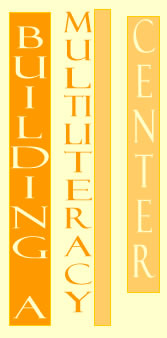

Consultant
Variety: Specialists and Non-Specialists
KHM: Also unique about your Multiliteracy Center is that you include
peer consultants that have a variety of backgrounds and levels of experience
with technology and media composing. Can you talk about how you see this
diversity influencing the design that you want in your Multiliteracy Center?
DS: Yes. I've already alluded to the fact that we have students from various backgrounds tutoring in the Multiliteracy Center. Some of them are near-professional graphic designers that are about to receive their degree in graphic design. Some of them are majoring in English, history, political science, or Education, who, for whatever reason, have gotten into this type of work. Sometimes they have learned web design specifically to work in the Multiliteracy Center. Other times, they have learned web design skills in the job that they've had or just through personal interest.
What
I think is really important in establishing a successful Center that does
what we hope to do, is to get people from a variety of backgrounds talking
to each other and interacting with each other and with the students. What
I've noticed is that our consultants who are not graphic design majors,
learn a lot from the graphic design majors. But also, the graphic design
majors learn a lot from the non-specialists. In fact, a lot of the non-specialists
are technically more proficient at web design. The non-specialists are
also, in some ways, rhetorically more proficient because they have more
experience in web design. A lot of the graphic design curriculum is still
very paper-based.
The graphic design majors we have know Photoshop inside and out, they
know Illustrator inside and out, and they know Adobe InDesign (which is
a program that we don't really use a lot in the Multiliteracy Center).
But they have more limited experience with Dreamweaver and with the whole
process of composing for the web. I mean they, as graphic designers, bring
a lot to the composing process, and they understand that there's a difference
in using screen space and the importance of visual communication. They
understand a lot that they've really worked hard to learn. But you take
somebody who doesn't have that formal training but has designed twelve
websites in a professional capacity; they bring a really important component
to our program. They also understand what it's like to be a layperson
learning this stuff, just like the students that see them.
So I really think the best thing about the whole program is bringing in
all of these different students with different backgrounds and trying
to allow for spaces for them to meaningfully interact and talk with each
other.
And that hasn't always been easy to do, because as we make up the weekly
schedule, we only have a handful of consultants. We can't always schedule
even two people to work at the same time, because we want to make a certain
number of hours of consulting available. But what I've tried to do is
make sure that there's at least some overlap in scheduling -- that each
consultant works with at least one other consultant at some point. And
then we also try to have whole group meetings periodically. Although that's
hard as well, depending on the resources that you might have to pay people
to meet, finding time that's usually convenient, and having incentive
for students to meet if you're not going to pay them.
So there are challenges, but I think it's really important to allow them
to interact with each other and talk to each other. Unlike the traditional
tutoring, we see a lot more of collaborative tutoring, where you have
more than one student composer and more than one consultant working. So
you might have four people working together instead of one-on-one. We
see a lot more of that, and I think that's a really good thing.
KHM: It sounds valuable for student clients, as well, so they're also seeing and interacting with different models of technology users and designers. I imagine that making visible each individual's proficiency with technology and valuing the contribution each can make is a real benefit for learners.
DS:
That's right. The graphic designers,
for instance, are very sensitive to this notion that they're not talking
to graphic designers and that they have to make what they know accessible
to the non-specialist. But, after all, they are specialists, and that
has advantages and limitations. And I think the technology user and the
web designer who is, sort of, self-taught, and has come across this knowledge
through that nontraditional route: there's a lot of value in that. And,
I think the clients who work with those students, like you said, they're
seeing a different model and those things resonate in different ways.
Top | Next
What I've noticed is that our consultants who are not graphic design majors, learn a lot from the graphic design majors. But also, the graphic design majors learn a lot from the non-specialists."